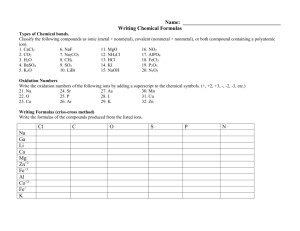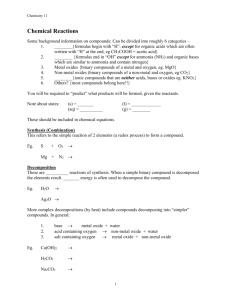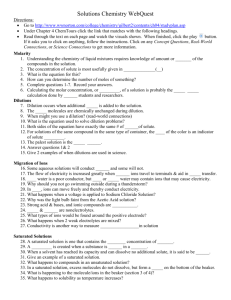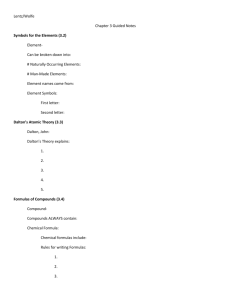Reactions Quick Reference
advertisement
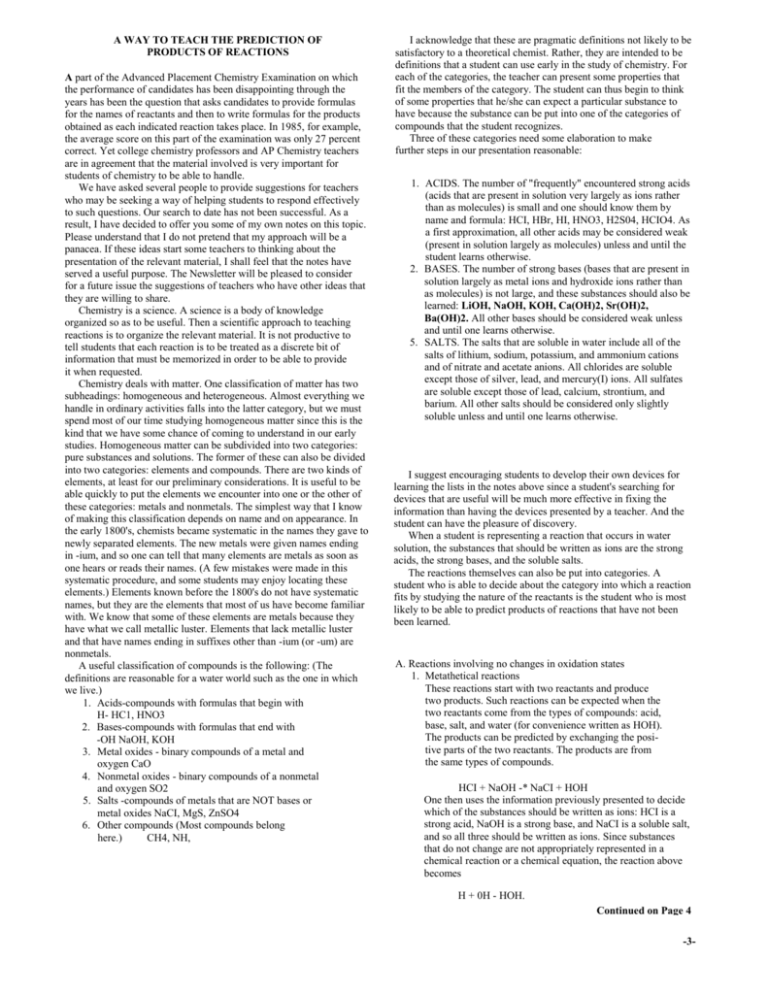
A WAY TO TEACH THE PREDICTION OF PRODUCTS OF REACTIONS A part of the Advanced Placement Chemistry Examination on which the performance of candidates has been disappointing through the years has been the question that asks candidates to provide formulas for the names of reactants and then to write formulas for the products obtained as each indicated reaction takes place. In 1985, for example, the average score on this part of the examination was only 27 percent correct. Yet college chemistry professors and AP Chemistry teachers are in agreement that the material involved is very important for students of chemistry to be able to handle. We have asked several people to provide suggestions for teachers who may be seeking a way of helping students to respond effectively to such questions. Our search to date has not been successful. As a result, I have decided to offer you some of my own notes on this topic. Please understand that I do not pretend that my approach will be a panacea. If these ideas start some teachers to thinking about the presentation of the relevant material, I shall feel that the notes have served a useful purpose. The Newsletter will be pleased to consider for a future issue the suggestions of teachers who have other ideas that they are willing to share. Chemistry is a science. A science is a body of knowledge organized so as to be useful. Then a scientific approach to teaching reactions is to organize the relevant material. It is not productive to tell students that each reaction is to be treated as a discrete bit of information that must be memorized in order to be able to provide it when requested. Chemistry deals with matter. One classification of matter has two subheadings: homogeneous and heterogeneous. Almost everything we handle in ordinary activities falls into the latter category, but we must spend most of our time studying homogeneous matter since this is the kind that we have some chance of coming to understand in our early studies. Homogeneous matter can be subdivided into two categories: pure substances and solutions. The former of these can also be divided into two categories: elements and compounds. There are two kinds of elements, at least for our preliminary considerations. It is useful to be able quickly to put the elements we encounter into one or the other of these categories: metals and nonmetals. The simplest way that I know of making this classification depends on name and on appearance. In the early 1800's, chemists became systematic in the names they gave to newly separated elements. The new metals were given names ending in -ium, and so one can tell that many elements are metals as soon as one hears or reads their names. (A few mistakes were made in this systematic procedure, and some students may enjoy locating these elements.) Elements known before the 1800's do not have systematic names, but they are the elements that most of us have become familiar with. We know that some of these elements are metals because they have what we call metallic luster. Elements that lack metallic luster and that have names ending in suffixes other than -ium (or -um) are nonmetals. A useful classification of compounds is the following: (The definitions are reasonable for a water world such as the one in which we live.) 1. Acids-compounds with formulas that begin with H- HC1, HNO3 2. Bases-compounds with formulas that end with -OH NaOH, KOH 3. Metal oxides - binary compounds of a metal and oxygen CaO 4. Nonmetal oxides - binary compounds of a nonmetal and oxygen SO2 5. Salts -compounds of metals that are NOT bases or metal oxides NaCI, MgS, ZnSO4 6. Other compounds (Most compounds belong here.) CH4, NH, I acknowledge that these are pragmatic definitions not likely to be satisfactory to a theoretical chemist. Rather, they are intended to be definitions that a student can use early in the study of chemistry. For each of the categories, the teacher can present some properties that fit the members of the category. The student can thus begin to think of some properties that he/she can expect a particular substance to have because the substance can be put into one of the categories of compounds that the student recognizes. Three of these categories need some elaboration to make further steps in our presentation reasonable: 1. ACIDS. The number of "frequently" encountered strong acids (acids that are present in solution very largely as ions rather than as molecules) is small and one should know them by name and formula: HCI, HBr, HI, HNO3, H2S04, HCIO4. As a first approximation, all other acids may be considered weak (present in solution largely as molecules) unless and until the student learns otherwise. 2. BASES. The number of strong bases (bases that are present in solution largely as metal ions and hydroxide ions rather than as molecules) is not large, and these substances should also be learned: LiOH, NaOH, KOH, Ca(OH)2, Sr(OH)2, Ba(OH)2. All other bases should be considered weak unless and until one learns otherwise. 5. SALTS. The salts that are soluble in water include all of the salts of lithium, sodium, potassium, and ammonium cations and of nitrate and acetate anions. All chlorides are soluble except those of silver, lead, and mercury(I) ions. All sulfates are soluble except those of lead, calcium, strontium, and barium. All other salts should be considered only slightly soluble unless and until one learns otherwise. I suggest encouraging students to develop their own devices for learning the lists in the notes above since a student's searching for devices that are useful will be much more effective in fixing the information than having the devices presented by a teacher. And the student can have the pleasure of discovery. When a student is representing a reaction that occurs in water solution, the substances that should be written as ions are the strong acids, the strong bases, and the soluble salts. The reactions themselves can also be put into categories. A student who is able to decide about the category into which a reaction fits by studying the nature of the reactants is the student who is most likely to be able to predict products of reactions that have not been been learned. A. Reactions involving no changes in oxidation states 1. Metathetical reactions These reactions start with two reactants and produce two products. Such reactions can be expected when the two reactants come from the types of compounds: acid, base, salt, and water (for convenience written as HOH). The products can be predicted by exchanging the positive parts of the two reactants. The products are from the same types of compounds. HCI + NaOH -* NaCI + HOH One then uses the information previously presented to decide which of the substances should be written as ions: HCI is a strong acid, NaOH is a strong base, and NaCI is a soluble salt, and so all three should be written as ions. Since substances that do not change are not appropriately represented in a chemical reaction or a chemical equation, the reaction above becomes H + 0H - HOH. Continued on Page 4 -3- TEACHING REACTION PRODUCTS Continued from Page 3 2. Some combination reactions related to metathetical reactions These reactions produce a single product predictable from the types of the reactants indicated with each of the examples below. Metal oxide + water -* a base, the metal in the same oxidation state as in the oxide CaO(s) + HOH -* Ca(OH)2 Then revised to CaO(s) + HOH - Ca 2 + 0H Nonmetal oxide + water -* an acid, the nonmetal in the same oxidation state as in the oxide SO2 + HOH - 112S03 (no strong acid or strong base or soluble salt, so no ions) Metal oxide + nonmetal oxide -* salt, with the nonmetal appearing in a radical where it has the same oxidation state as in the oxide CaO + SO2 - CaSO3 (no strong acid or strong base or soluble salt, so no ions) 3. Some decomposition reactions (the reverse of the combination reactions in the category just above) There is one reactant and there are two products in each of these reactions. Base -+ metal oxide + water Ca(OH)2(s) - CaO(s) + HOH Acid containing oxygen - nonmetal oxide + water H2C03 - CO2 + HOH Salt containing oxygen - metal oxide + nonmetal oxide CaCO3(s) - CaO(s) + CO2 4. Hydrolysis reactions The reactions of salts with water can usually be handled as metathetical reactions. In addition to salts, some of the Other compounds (category 6 above), particularly nonmetallic halides, react with water. If the water is written as HOH, combining the H from the water with the more (or most) electronegative element from the other compound usually gives the formula for one of the products. The other product contains the remaining elements. The formula for this second compound usually needs to be rearranged in order to make clear its acidic properties. PCI3 + HOH -, HCI + P(OH)3 rearranged to [H3P03] or, more accurately, to H2PHO3 5. Reactions of coordination compounds and ions The number of different reactions falling into this category that are considered in general chemistry courses is rarely large. The ligands most frequently considered, attached to a central atom that is usually a metal ion, are the ammonia molecule and the hydroxide ion. Writing the reactions that form the coordination ions requires (1) recognition of the possibility of the formation of the coordination ion when an ample source of the ligands is available and (2) knowledge of the metal ions likely to form coordination ions, of what the common ligands are, and of the likely number of the ligands to be attached to the central ion. It may be useful to keep in mind that the number of ligands attached to a central metal ion is sometimes twice the oxidation number of the central metal: Ag(NH3)2, Zn(OH)42. The breakup of these coordination ions is frequently achieved by adding an acid. The products are the metal ion and the species formed when hydrogen ions from the acid react with the ligand (NH4 from NH3 and HOH from OH-). +H A13Al(OH)4_ + HOH 6. Reactions based on nonwater definitions of acids and bases Both Brönsted and Lewis definitions of acids and bases can be illustrated by the writing of equations. Recognizing that an acid and a base are the reactants according to one of the definitions and knowing how they react is the best approach for the writing of such reactions: BrOnsted reactions involve the transfer of a proton. Lewis reactions involve the formation of a coordinate covalent bond. B. Reactions involving changes in oxidation states 1. Some combination reactions Two elements react to form a binary compound of the two. The symbol for the more electropositive element is written first and valence relations are used to obtain the formula. 2. Reactions between an oxidizer and a reducer Products from such reactions can usually be predicted from knowledge about a limited number of oxidizers and reducers. A useful list of such reagents follows: Important oxidizers Formed in the reaction MnO4 in acid solution Mn2 Mn02 in acid solution Mn2 MnO4 in neutral or basic solution MnO2 Cr2072 - in acid solution Cr3 + HNO3, concentrated NO2 HNO3, dilute NO H2S04, hot, concentrated SO2 Metal-ic ions metal-ous ions Free halogens halide ions Na2O2 NaOH HCIO4 Cl Important reducers Halide ions Free metals Sulfite ions (or SO2) Nitrite ions Free halogens, dil. basic soln. Free halogens, conc.basic soln. Metal-ous ions Formed in the reaction Free halogen Metal ions Sulfate ions Nitrate ions Hypohalite ions Halate ions Metal-ic ions To predict products of a reaction that fits into this category, a student looks at the reagents given in the question to see if there are available both an oxidizer and a reducer. This step may involve recognizing the ions that are parts of the compounds listed as the reagents. Then one can write the appropriate products from the oxidizer and the reducer present. One keeps in mind the acid or the base present if an acid or a base is listed as a reactant. In acidic solutions, any metal ions formed can combine with the anion of the acid to form salts. Keeping in mind the solubilities of the salts, one can then predict whether the products include a precipitated salt or whether ions are the appropriate products. In basic solu- Continued on Page 5 -4- TEACHING REACTION PRODUCTS Continued from Page 4 tions, any anions present can combine with the cation of the base present to form salts. Again, the solubility considerations indicate whether formulas of salts or of ions should be written as products. (In case the requirement is that molecular equations - equations with no ions - are to be written, the preceding sentences indicate how the molecular formulas can be developed.) 3. Displacement reactions The reactants are an element and a compound. A more reactive element (in the free state) can displace a less reactive element with similar properties from a compound. The products are the less reactive element and a compound containing the more reactive element. For example, zinc metal reacts with tin(II) sulfate to form zinc sulfate and metallic tin, and free chlorine reacts with sodium bromide to form sodium chloride and free bromine. A list of reduction potentials can be consulted to determine which of the elements present is the more reactive. C. Organic reactions Predicting the products of the limited number of organic reactions appropriate for the Advanced Placement Chemistry Examination requires knowing the formula that is characteristic for each of the very important homologous series of organic compounds. For example, C, H2112 is such a formula for the alkanes. Such formulas for the other major hydrocarbon series and for alcohols, acids, ethers, esters, and amines (probably the reactants to be expected) and the structural formulas for a typical compound or two from each series are the facts that students should have to be able to write these reactions. The more common types of reactions include the following: 1. Oxidation Complete oxidation of any organic compound containing no elements but carbon, hydrogen, and oxygen yields carbon dioxide and water. Partial oxidation products depend on the reactant and so are not generally predictable. 2. Addition These reactions, which form only one product, are the characteristic reactions of the hydrocarbon series whose members have double or triple bonds. 3. Substitution These reactions give two products. Any hydrocarbon can show this type of reaction. It is the characteristic reaction for the hydrocarbon series that have no multiple bonds. A hydrogen atom leaves the organic compound and is bonded to an atom or atoms from the nonorganic reactant. The place of the hydrogen in the organic compound is taken by an atom or radical from the nonorganic reactant. 4. Esterification An organic acid reacts with an alcohol to form an ester and water. 5. Saponification. An ester reacts with a strong base to form a salt, which may be a soap, and an alcohol. Students must come to realize that information about specific substances is still needed to do well with the handling of some reactions. For example, after one knows that an acid decomposes to form a nonmetal oxide and water, one must still know which acids undergo this reaction at room temperature. Organization of the material, however, does provide a framework into which specific facts can be fitted. Since the type of question from the AP Chemistry Examination that we are considering gives the names of the reactants rather than the formulas for them, students need to be able to write formulas from names. Systematic presentation of nomenclature is important for helping students to be successful. As a course proceeds, the lists of substances that fit into the categories considered can be extended to fit the content of the particular course. I suggest that this array of material not be presented at one time but that it be divided into a number of segments, each segment being presented at an appropriate location in the course along with indications to students that there is under development a "grand design" that will provide organization for a large body of the material included in a good general chemistry course. I have a warning about the use of classification systems. I believe that we as teachers have a responsibility to make clear to students that any classification we use is one that we find convenient for a particular situation. For one thing, there may be exceptions to the classification. (The Creator may not have had our classification in mind when the matter we are classifying came into being.) Furthermore, a completely different classification may be the one to use in a different situation. Finally, for understandable reasons, authors may be a bit dogmatic about a classification when they prepare their manuscripts. No doubt, some students prefer a dogmatic approach. They may gain confidence from thinking that they know the answers to all of the questions that they may be asked. As teachers we should remind our students that even the best educated of us do not know everything and that there are still important facts that nobody yet knows. Frank Fornoff PUBLICATIONS FOR AP CHEMISTRY Item number 201455 254954 208945 235500 273640 Title 1986 AP Course Description in Chemistry Set of free-response questions used in recent years Beginning an AP Chemistry Course Grading the AP Examination in Chemistry Hints for the Advanced Placement Chemistry Examination Price $5 $2 $5 $5 Singl e copie s on request Advanced Placement Chemistry Newsletter The Entire 1984 AP Chemistry 468223 Examination and Key $5 254301 The above examination only (packets of 10) $20 ORDERING INFORMATION All orders should be mailed to Advanced Placement Program, CN 6670, Princeton, New Jersey 08541-6670 273606 Prices are subject to change without notice. Orders will be filled with the currently available edition, unless purchaser specifies otherwise with order. Please make checks payable to College Board Publications. Payment must accompany any order not submitted on an institutional purchase order. Postage will be charged for orders that require billing; the College Board pays postage on all prepaid orders. Shipment will be made within 30 days of receipt of the order. Allow 4-6 weeks for delivery of an order. Orders are routinely sent the most economical way. If quicker delivery is requested, postage will be billed. Drop shipments will be charged $1 per address. 20% discount on orders for 5 or more copies of a single title shipped to the same location. -5-

